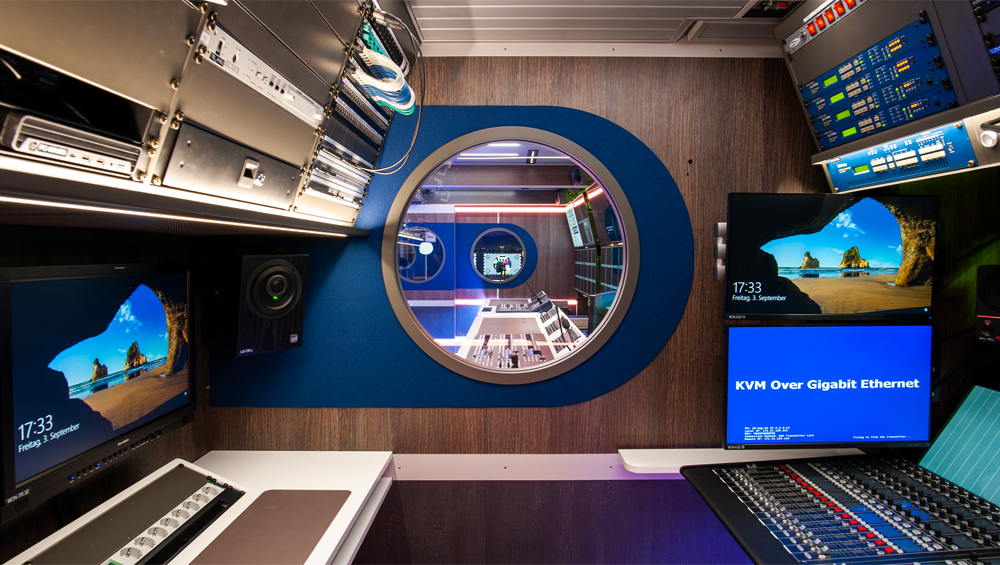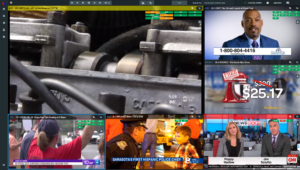
Multiviewers Take On Bigger Workloads

Even as multiviewers become more sophisticated, vendors are increasingly adding multiviewer capabilities to other products.
Some multiviewers are standalone units, while others are combined with different pieces of the broadcast workflow. Whether they operate in an SDI, IP or hybrid environment, they are often called on to handle a mix of formats as well as an increased amount of content being monitored.
At the same time, they need to make it quick and easy to locate problems with video content.
While some vendors offer only standalone multiviewers or multiviewers integrated into other products, Grass Valley offers both varieties.
“There’s still a need for purpose-built multiviewers” that are either hardware- or software-based, says Martin Jolicoeur, Grass Valley director of product management.
At the same time, he adds, multiviewers are also becoming features of other products, like the GV AMPP (Agile Media Processing Platform).
The platform supports processing functions and needs for media creation, production and playout, and the “multiviewer can spin up and down as part of that platform. They become a tool out of a bigger ecosystem,” Jolicoeur says.
Blackmagic President Dan May says some customers buy the company’s ATEM switchers “just to have the multiviewer,” which is built into the system.
The company built a multiviewer into ATEM for live production to make it possible to track all the feeds in a live production environment, he says. The result is an easy-to-use programmable solution that doesn’t overwhelm new users, he says.
Nigel Spratling, VP of production switchers and server systems at Ross Video, says the company doesn’t sell standalone multiviewers.
Because the capability is an essential part of monitoring, he says, including multiviewing in other products was a simple way to offer multiviewing of sources, particularly in larger routing systems where lots of sources need to be continuously monitored.
“What we’ve been working toward is the consolidation of separate pieces of equipment or technologies and really refining them down to smaller and single instances,” Spratling says. “We call it hyper convergence.”
The idea is that fewer pieces of equipment means more space, particularly in places like OB vans, he says. Radiotelevisione italiana (RAI) outfitted a truck with the hyperconverged technology, which includes a multiviewer, he says.
Ryan Wallenberg, VP of engineering at Cobalt, says one of the market segments it targets for multiviewers is station groups. Typically, he says, a central location will have one device per affiliate to allow for quality check options like detecting frozen video or loss of audio or missing captions.
“These also tie into automation systems” that can send out alerts, he says. “Broadcasters are asking for quality control monitoring. They don’t want someone watching something 24/7, especially if that central location has 30 or 40 unique stations. They want something that can automatically monitor and alert if something goes wrong.”
Apantac President Thomas Tang says traditional keyboard video mouse (KVM) allows users to look at one server at a time but multiviewers allow more servers and computers to be monitored at one time.
“By having a multiviewer and traditional KVM behind it, you can get to every window and can drill down into multiple computers,” he says. “It’s like 3D KVM.”
Apantac had a KVM plus multiviewer installation for Studio Berlin last year.
“The do everything you can do within our system,” he says. “It’s cascaded, multiple rooms, all tied together.”
Ric Belding, senior director of sales engineering and strategy at Vela, calls multiviewers a quickly growing component of the industry.
“They used to be rudimentary things in master control to see what things looked like,” he says. “Now they monitor how things are being received.”

A Vela multiviewer showing alarm statuses.
And different parts of the workflow have different needs when it comes to multiviewers, he says.
“Engineering needs one style, but multiple program distribution needs are different,” Belding says.
Vela offers seven types of multiviewers, which he says users can access through a web browser interface or standalone app on a computer.
And station infrastructure can be a big factor in choice of a multiviewer, as some are meant for IP installations, some for SDI, and some for hybrid.
Lawo CMO Andreas Hilmer says future-oriented stations should compare the footprint, required rack space and estimated power consumption of the various pieces of equipment, like multiviewers, under consideration.
“With modern IP infrastructure, you can significantly reduce the footprint,” he says.
Lawo’s multiviewer relies on MIP map technology to reduce bandwidth needs.
John Mailhot, the CTO of Imagine’s networking and infrastructure business, says multiviewers once designed around the SDI workflow are now made to be fully IP and part of a true IP workflow. And that means a lot of redundancy in the system.
“In the old days, if you looked at the signal on the wall and you see it there, OK, that’s great. There must not be anything wrong. But in the new IP-based systems, there’s a lot of resiliency built into it” with redundant fibers and switches, he says. “You can have a lot of things in the system fail and all the pips on the wall will still look good.”
It’s important to realize that errors can be happening that don’t “affect the picture yet,” he says. “If one redundant path is not working, you need an indicator about that.”
Mailhot says the multiviewer landscape is working through what’s required to deal with high dynamic range (HDR) and ultra high definition (UHD).
For HDR, he says, “the signal in the network has a very different transfer characteristic than the display you might be putting it on.”
And scaling for UHD output can lead to “a lot of data to manage.”
As such, he says, new multiviewer products are often designed to address challenges presented by UHD and HDR.
One project Imagine did was for the NFL news center, which is using Imagine’s multiviewer in a facility designed for HDR and UHD capability.
“It was used through the NFL season and culminated in the Super Bowl,” he says.
Multiviewers also need to be able to handle 4K, says Andrew Gong, business development specialist at Avitech.
He says Avitech is releasing a new KVM multiviewer product later this year that can handle 4K resolution and 60 hertz frame rate. That product is currently in beta with clients, he says.
“We’ve had 4K 30 [Hz] for about five years and with 4K 60 [Hz] we’re seeing these displays and all these other components in a system become really mature and really affordable,” he says.
Mo Goyal, senior director international business development at Evertz, says it’s important for multiviewers to be able to handle both compressed and uncompressed video.
“There’s still a growing need for multiple formats,” he says.
And this is all complicated by the fact that on-prem and cloud have different formats and signal types, he says.
The need for multiviewing capability isn’t going away, Goyal adds. “It’s always going to be a requirement,” he says, because productions are always adding more cameras and feeds. That means it’s necessary to monitor all of those signals. “Productions have definitely evolved from the mere 20 or 30 cameras to 100 cameras and more.”
In the end though, a multiviewer is expected to help alert broadcasters to problems with their feeds.
Ken Rubin, senior VP at Actus Digital, says the company’s multiviewer makes it possible for users to “pinpoint where in the workflow an issue started” so it can be quickly remedied.
“We help them pinpoint where are the issues in their workflow,” he says.
































Comments (0)